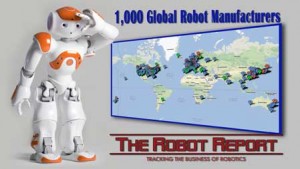
Robohub.org
1,000 Robot Makers!
Well — almost 1,000. Presented on this map are 977 robot manufacturers and the top 20 robotics universities and research facilities. Every type of company; every facet of the industry; most industrialized countries of the world are represented. From big companies like KUKA, ABB and Fanuc to start-ups like Redwood Robotics in California and Etnamatica in Sicily; from Iceland to Western Australia. These companies are robot makers; they may or may not also be robot users. That’s for another map.
Red markers reflect 200+ industrial robot makers; Green is for the 170+ start-up companies; and Blue is separated into two groups: “S” for service robots for governmental and corporate use while “P” covers service robots for private or personal use. Yellow is used to show the location of the top 20 robotic research and educational facilities. A country-by-country table is shown below.
The global map does not cover an additional 825 ancillary businesses such as image systems, software developers, engineering and consulting firms, integrators and resellers, designers, servo, laser and stereo camera providers, etc. Nor does it cover 225 other educational facilities and research labs. These can be found in our Ancillary Businesses and Educational and Research Facilities Directories.
The map is also limited by my own research capabilities, language translation limitations, and scarcity of information about robotics companies in emerging countries. It show a single entry for a company headquarters regardless how many branches, subsidiaries and locations that company might have.
In spite of all those caveats, at first glance I was impressed by the sheer quantity of the markers. One can easily see that many of the start-ups and service robotics companies are located near prominent Yellow-marked universities and research labs in clusters surrounding Carnegie Mellon, MIT and Harvard, UC Berkeley, Stanford and Willow Garage, the University of Tokyo and TITECH, etc. Or areas of innovation and energy like Seoul, Korea, Israel and New York City.
Red markers – industrial robot makers – stand out for their predominance in the industrial sections of the world: Germany, Switzerland and Central and Western Europe and the UK, Japan, Korea and the Great Lakes area of the US.
Blue markers – service robots (every other type of robot except industrial) are everywhere as are Green start-up markers. These are the emerging robotics companies in non-industrial robotics: robots used in healthcare, scientific labs, for defense and security, in academia, as toys, for remote presence and autonomous mobility underwater, on the ground and in the air and for a myriad of other uses.
This map will continue to grow above the 1,000 mark as I continue my research. If I’ve missed your company or companies that you know about, please send me a message.
Frank Tobe
is the owner and publisher of The Robot Report, and is also a panel member for Robohub's Robotics by Invitation series.
Frank Tobe
is the owner and publisher of The Robot Report, and is also a panel member for Robohub's Robotics by Invitation series.
Related posts :
Robot Talk Episode 126 – Why are we building humanoid robots?
Robot Talk
20 Jun 2025
In this special live recording at Imperial College London, Claire chatted to Ben Russell, Maryam Banitalebi Dehkordi, and Petar Kormushev about humanoid robotics.
Gearing up for RoboCupJunior: Interview with Ana Patrícia Magalhães
AIhub and Lucy Smith
18 Jun 2025
We hear from the organiser of RoboCupJunior 2025 and find out how the preparations are going for the event.
Robot Talk Episode 125 – Chatting with robots, with Gabriel Skantze
Robot Talk
13 Jun 2025
In the latest episode of the Robot Talk podcast, Claire chatted to Gabriel Skantze from KTH Royal Institute of Technology about having natural face-to-face conversations with robots.
Preparing for kick-off at RoboCup2025: an interview with General Chair Marco Simões
AIhub and Lucy Smith
12 Jun 2025
We caught up with Marco to find out what exciting events are in store at this year's RoboCup.
Interview with Amar Halilovic: Explainable AI for robotics
AIhub
10 Jun 2025
Find out about Amar's research investigating the generation of explanations for robot actions.
Robot Talk Episode 124 – Robots in the performing arts, with Amy LaViers
Robot Talk
06 Jun 2025
In the latest episode of the Robot Talk podcast, Claire chatted to Amy LaViers from the Robotics, Automation, and Dance Lab about the creative relationship between humans and machines.
Robot Talk Episode 123 – Standardising robot programming, with Nick Thompson
Robot Talk
30 May 2025
In the latest episode of the Robot Talk podcast, Claire chatted to Nick Thompson from BOW about software that makes robots easier to program.
Congratulations to the #AAMAS2025 best paper, best demo, and distinguished dissertation award winners
AIhub
29 May 2025
Find out who won the awards presented at the International Conference on Autonomous Agents and Multiagent Systems last week.




